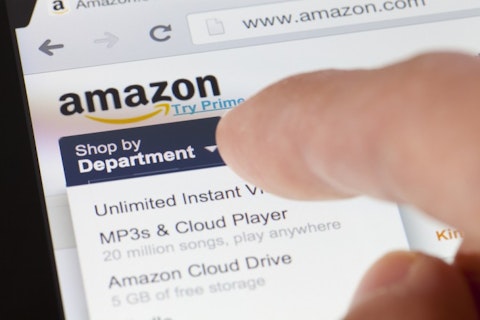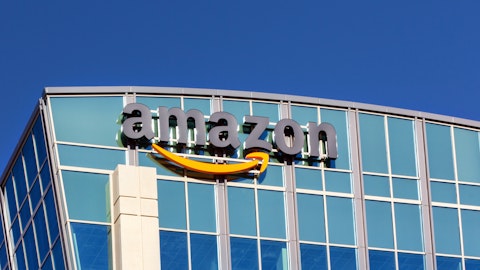Starting later this year Amazon.com, Inc. (NASDAQ:AMZN) plans to offer grocery stores that will have no lineups or checkouts. So far the company has already set up its first brick and mortar store that sells food near its headquarters in Seattle, Washington. At the moment only Amazon employees can shop at the new grocery store, but the plan is to make it public soon.
The idea is that customers can walk in, pick up their items, and walk out of the store without taking any action to pay or check out. Instead of ringing each item up at a counter, sensors and computer vision record the items that were picked up and charges them directly to the customer’s Amazon Prime account. Shoppers will be able to get instant notification of their purchase with a digital receipt sent to their smartphones.
– This article appeared first on ModestMoney.com.

ymgerman / Shutterstock.com
The massive store measures 1,800 square feet and sells food staples such as milk, bread, chocolate and even prepared meals. Its opening follows the launch of a physical book store at the University Village in Seattle a year ago. The store contains 6,000 books. Each title was selected based on customer feedback and sales data from the Amazon.com website.
The new food store and book store are game changers for not just the internet giant, but also the grocery and book industries. It’s an example of how technology can disrupt the retail sector and try to fix inefficiencies in the market place outside of what technology companies normally do. Automating shopping services such as clerks would mean many low income, working Americans will lose their jobs.
The “Fight for 15” movement in the United States advocates for the government to mandate a minimum wage of $15 per hour for fast food workers. Many local officials have already started a series of increases that will see their city’s hourly wages climb to $15 by next year. San Fransisco is one city that is doing this. As the cost of labor increases, more corporations will likely spend more capital expenditures on machines rather than human resources.
But this may be good news for companies such as Amazon.com, Inc. (NASDAQ:AMZN). With a plan to integrate their products and services into the real world, and not just online, the retailer is in a very good position to take advantage of new technologies to help with the transition from human laborers to more automated systems. Amazon is one of the largest companies in the S&P 500 by market capitalization. Its stock has received a lot of attention over the last several years because its performance has been outstanding.
Since the company went public in 1997, its stock has returned about 38,000%. That’s an annual compounded rate of 35%. The company is certainly not cheap to buy at this point, yet about two-thirds of its shareholders are institutional investors. Maybe professional investment managers see something in this stock retail investors don’t. With an earnings multiple usually between 100 to 200-times, Amazon.com investors have to be able to stomach a lot of volatility. But with $138 billion in sales, it is currently the market leader in the online realm. It also has a huge cloud business which serves the needs of companies such as Netflix.
Overall Amazon.com, Inc. (NASDAQ:AMZN) has proven that it knows how to expand into new sectors of the economy using its technology and innovative strategies. The next challenge for Amazon is obviously becoming a big competitor to brick and mortar grocery companies. The potential appears to be there. If the growing trend of the business continues, then the stock, which is $757 per share today, could be higher by next year. But then again, the grocery retail business is very competitive.
Follow Amazon Com Inc (NASDAQ:AMZN)
Follow Amazon Com Inc (NASDAQ:AMZN)
About the Author: Kevin
Disclosure: This author owns 10 shares of AMZN as of writing this post.
Note: This post was originally published on ModestMoney.com. Check out their site for the latest investing news and analysis.





